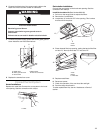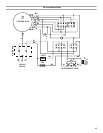
7
Electrical Requirements
For GZ or IH model series:
WARNING: To reduce the risk of fire or electrical shock, do not
use this fan with any solid state speed control device.
For KWVU model series:
This fan is suitable for use with solid state speed controls.
IMPORTANT: Observe all governing codes and ordinances. Save
Installation Instructions for electrical inspector’s use.
It is the customer’s responsibility to contact a qualified electrical
installer, and to assure that the electrical installation is adequate
and in conformance with National Electrical Code, ANSI/NFPA 70
(latest edition), or CSA Standards C22.1-94, Canadian Electrical
Code, Part 1 and C22.2 No. 0-M91 (latest edition) and all local
codes and ordinances.
If codes permit and a separate ground wire is used, it is
recommended that a qualified electrician determine that the
ground path is adequate.
A copy of the above code standards can be obtained from:
National Fire Protection Association
One Batterymarch Park, Quincy, MA 02269
CSA International
8501 East Pleasant Valley Road
Cleveland, OH 44131-5575
■ A 120 Volt, 60 Hz., AC only 15-amp fused, electrical circuit is
required.
■ Do not ground to a gas pipe.
■ Check with a qualified electrician if you are not sure the range
hood is properly grounded.
■ Do not have a fuse in the neutral or ground circuit.
■ The range hood must be connected with copper wire only.
■ The range hood should be connected directly to the fused
disconnect (or circuit breaker) box through flexible armored or
nonmetallic sheathed copper cable.
■ Wire sizes (copper wire only) and connections must conform
with the rating of the appliance as specified on the model/
serial rating plate.
■ Wire sizes must conform to the requirements of the National
Electrical Code, ANSI/NFPA 70 (latest edition), or CSA
Standards C22.1-94, Canadian Electrical Code, Part 1 and
C22.2 No. 0-M91 (latest edition) and all local codes and
ordinances.
■ A ¹⁄₂" (12.7 mm) UL listed or CSA approved strain relief must
be provided at each end of the power supply cable (at the
range hood and at the junction box).
INSTALLATION INSTRUCTIONS
Prepare Location
It is recommended that the vent system be installed before hood
is installed.
Do not cut a joist or stud unless absolutely necessary. If a joist or
stud must be cut, then a supporting frame must be constructed.
Before making cutouts, make sure there is proper clearance
within the ceiling or wall for vent fittings.
Preparation
1. If possible, disconnect and slowly move the freestanding
range from the cabinet opening to provide easier access to
upper cabinet and rear wall.
2. Determine which venting method to use: roof, wall, or non-
vented.
3. Determine and clearly mark a centerline on the underside of
the cabinet.
4. Measure and mark lines as shown for your size of vent hood.
Use a saber saw or keyhole saw to cut an opening through
the underside of the cabinet.
The finished cutout size will be:
30" (76.2 cm) hood - 9³⁄₁₆" x 26¹⁄₈" (23.3 cm x 66.4 cm)
36" (91.4 cm) hood - 9³⁄₁₆" x 32¹⁄₈" (23.3 cm x 81.6 cm)
WARNING
Excessive Weight Hazard
Use two or more people to move and install range.
Failure to do so can result in back or other injury.
A. Centerline
A
1
¹⁄₂"
9
³⁄₁₆"
(3.8 cm)
(23.3 cm)
30" (76.2 cm) hood - 13
¹⁄₁₆"
(33.2 cm)
36" (91.4 cm) hood - 16
¹⁄₁₆"
(40.8 cm)


















